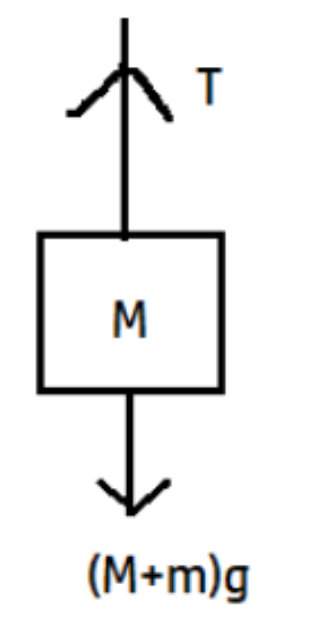
A person pulls a bucket of water from a well of depth h. If the mass of uniform rope is m and that of the bucket full of water is M, then work done by the person is:
(A) \[(M+\dfrac{m}{2})gh\]
(B) \[\dfrac{1}{2}(M+m)gh\]
(C) \[(M+m)gh\]
(D) \[(\dfrac{M}{2}+m)gh\]
Answer
567.3k+ views
Hint:Here the person is applying force on the rope to pull it upwards. On the bucket, two forces are acting one is the gravitational pull acting downwards and other is tension force in the string which acts in the upward direction.
Complete step by step answer:

We need to find the work done by the person. Work is defined as the dot product of force and displacement and it is a scalar quantity. There are two forces acting and despite that, the bucket moves upward.
Force on the bucket acting downward= mg
Force on the bucket acting upwards is not given, so we have to use here the work-energy theorem.
Work energy theorem states that work done is equal to the change in the potential energy of the object. The rope has a uniform mass m. So, the centre of mass for the rope is at half of the length of the rope.
Work done= \[Mgh+mg\dfrac{h}{2}=(M+\dfrac{m}{2})gh\]
This matches option (A), so the correct option is (A).
Note: Work-energy theorem states that the net work done by the forces on an object equals the change in its kinetic energy. Here if the upward force and displacement of the bucket would have been given then we would have been able to solve this problem by using Newton’s second law.
Complete step by step answer:

We need to find the work done by the person. Work is defined as the dot product of force and displacement and it is a scalar quantity. There are two forces acting and despite that, the bucket moves upward.
Force on the bucket acting downward= mg
Force on the bucket acting upwards is not given, so we have to use here the work-energy theorem.
Work energy theorem states that work done is equal to the change in the potential energy of the object. The rope has a uniform mass m. So, the centre of mass for the rope is at half of the length of the rope.
Work done= \[Mgh+mg\dfrac{h}{2}=(M+\dfrac{m}{2})gh\]
This matches option (A), so the correct option is (A).
Note: Work-energy theorem states that the net work done by the forces on an object equals the change in its kinetic energy. Here if the upward force and displacement of the bucket would have been given then we would have been able to solve this problem by using Newton’s second law.
Recently Updated Pages
Why are manures considered better than fertilizers class 11 biology CBSE

Find the coordinates of the midpoint of the line segment class 11 maths CBSE

Distinguish between static friction limiting friction class 11 physics CBSE

The Chairman of the constituent Assembly was A Jawaharlal class 11 social science CBSE

The first National Commission on Labour NCL submitted class 11 social science CBSE

Number of all subshell of n + l 7 is A 4 B 5 C 6 D class 11 chemistry CBSE

Trending doubts
What is meant by exothermic and endothermic reactions class 11 chemistry CBSE

10 examples of friction in our daily life

One Metric ton is equal to kg A 10000 B 1000 C 100 class 11 physics CBSE

1 Quintal is equal to a 110 kg b 10 kg c 100kg d 1000 class 11 physics CBSE

Difference Between Prokaryotic Cells and Eukaryotic Cells

What are Quantum numbers Explain the quantum number class 11 chemistry CBSE




